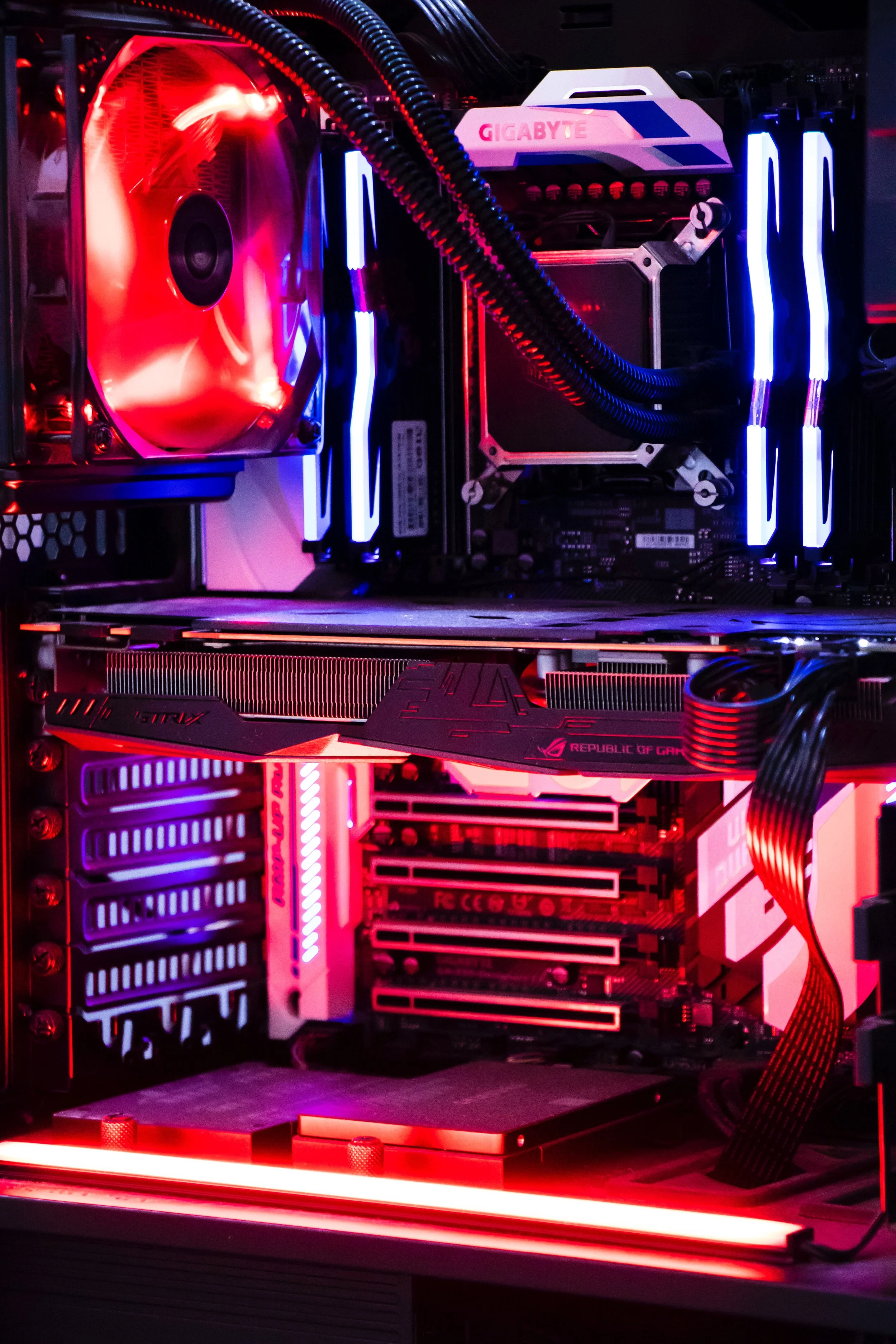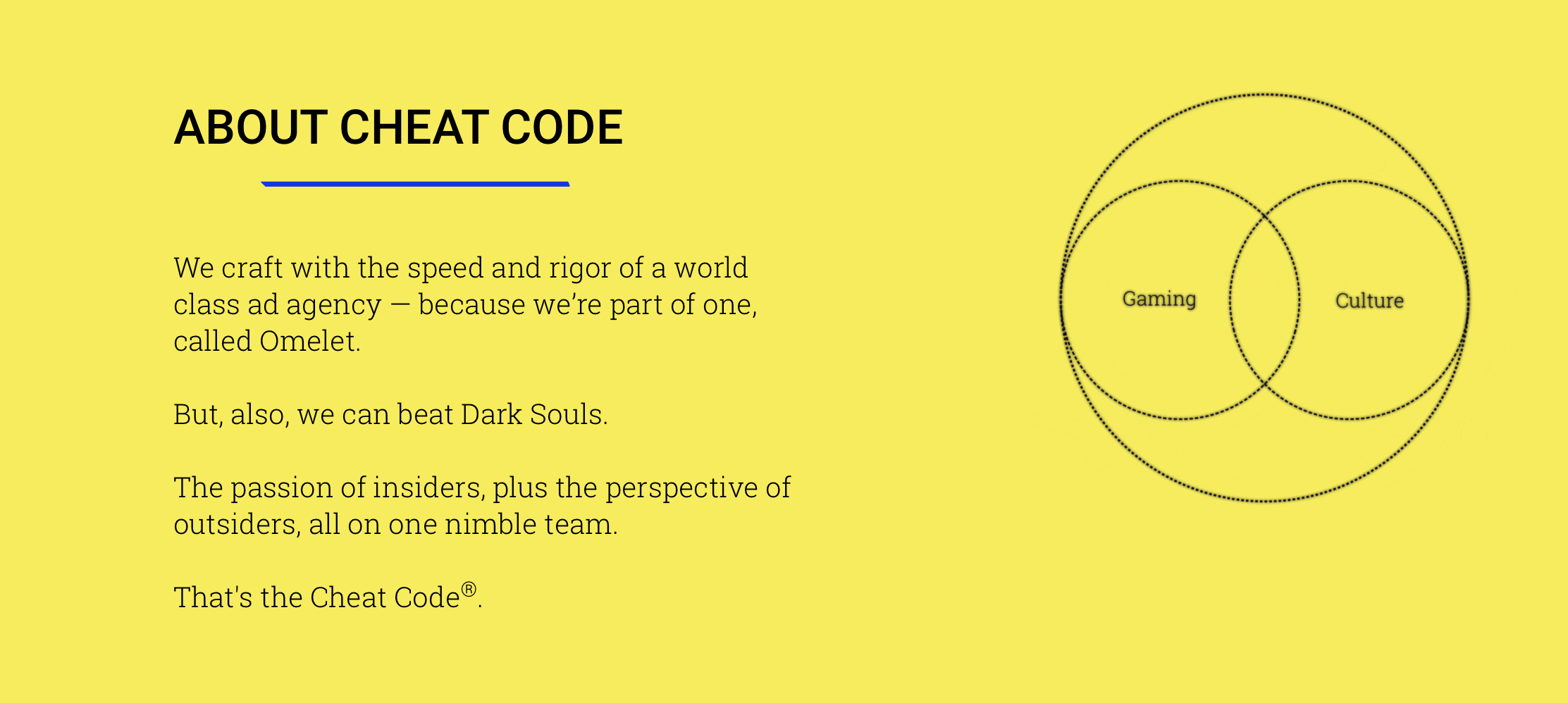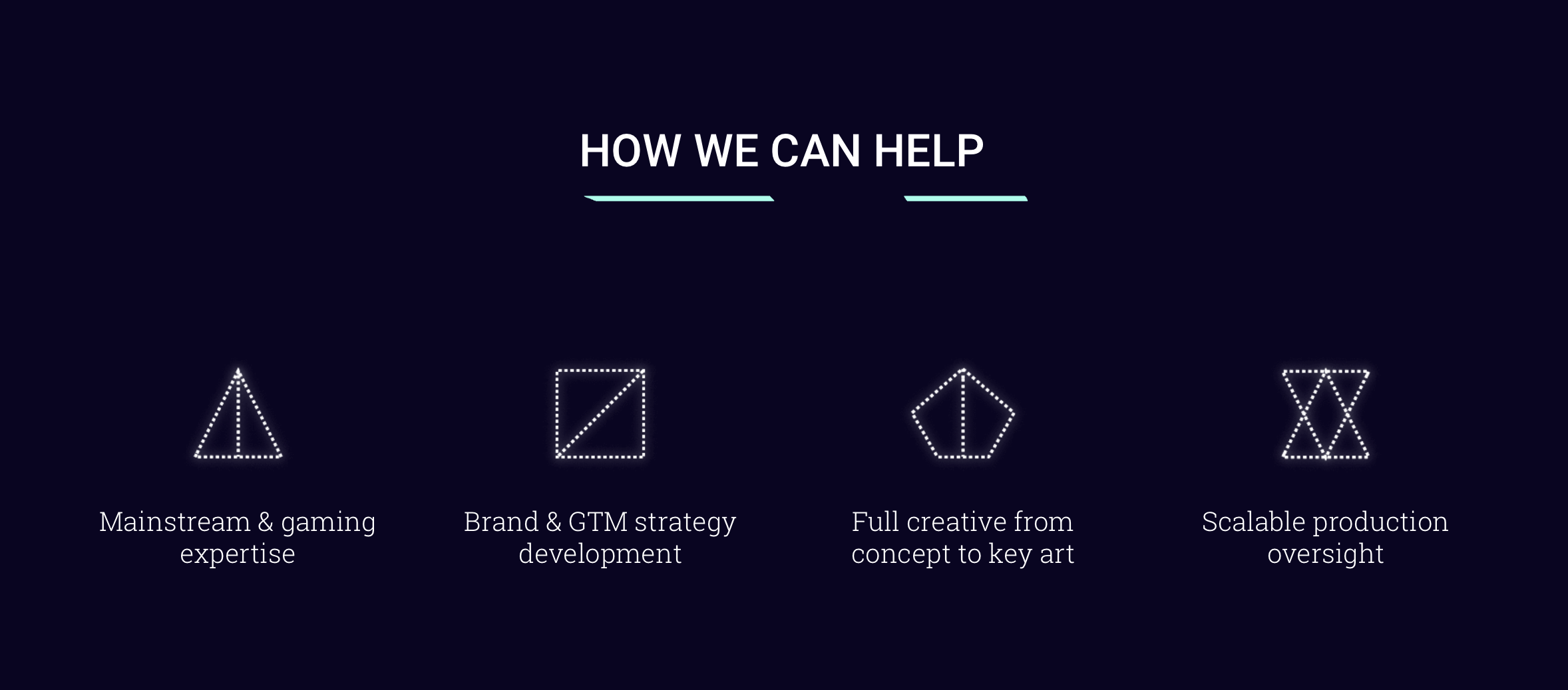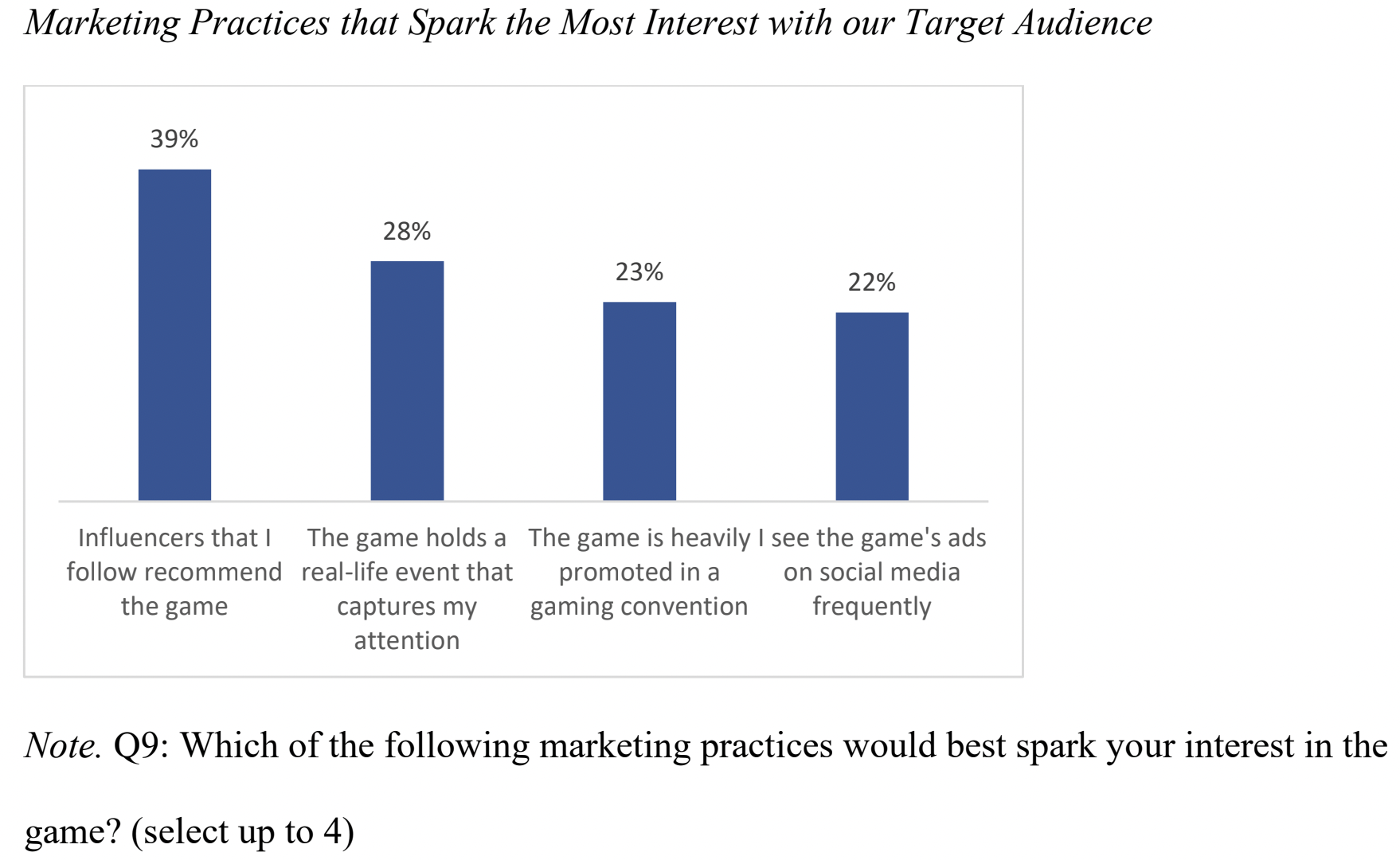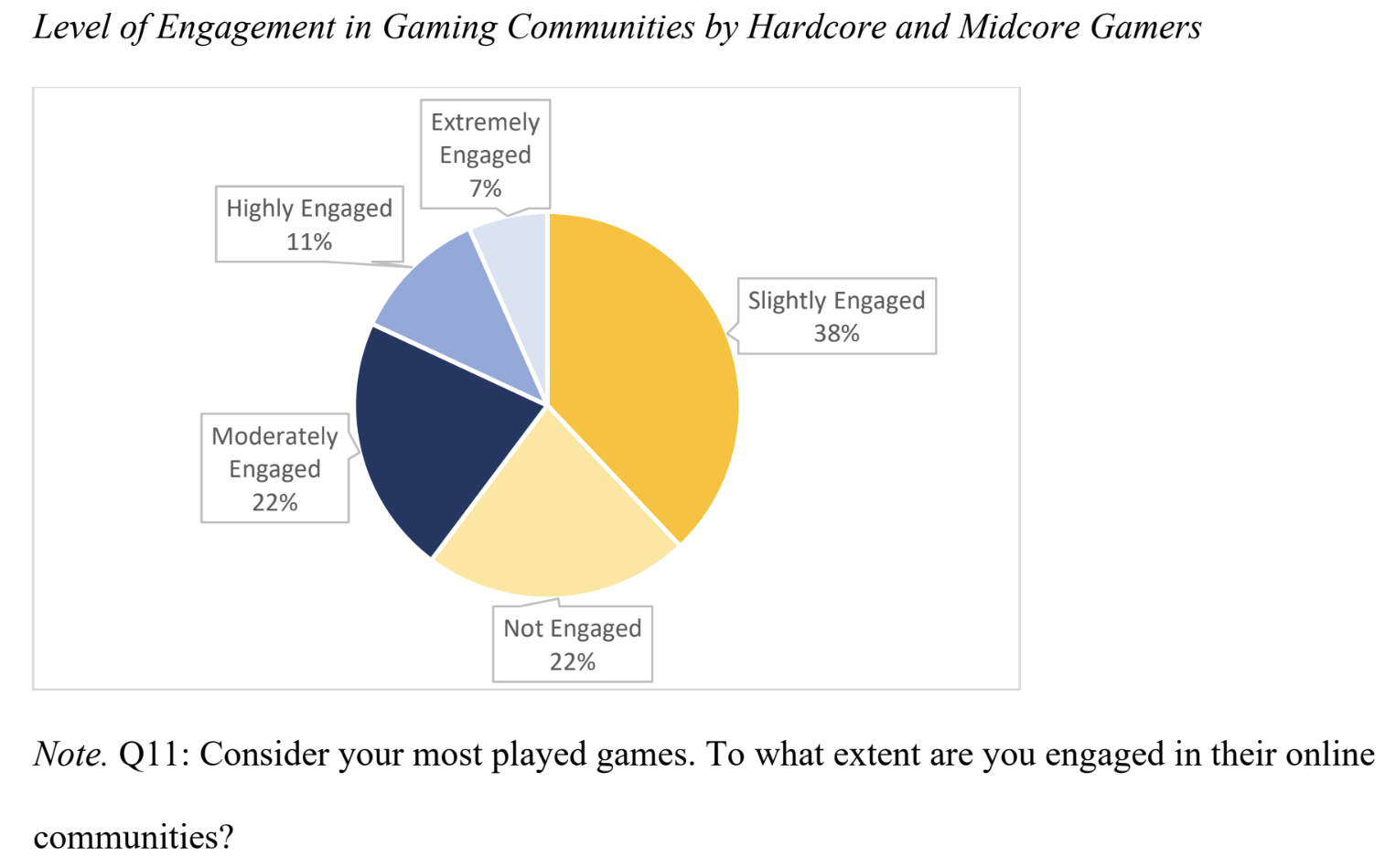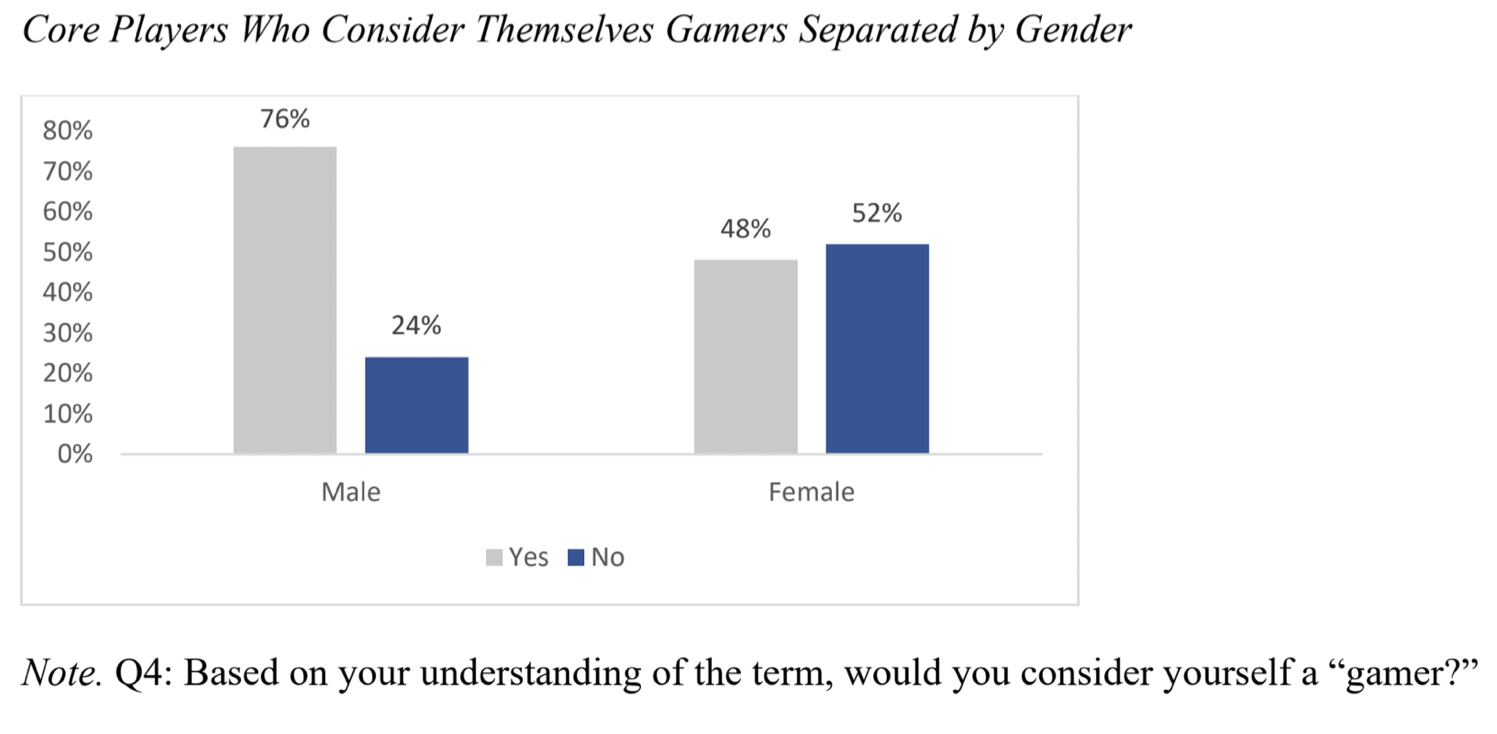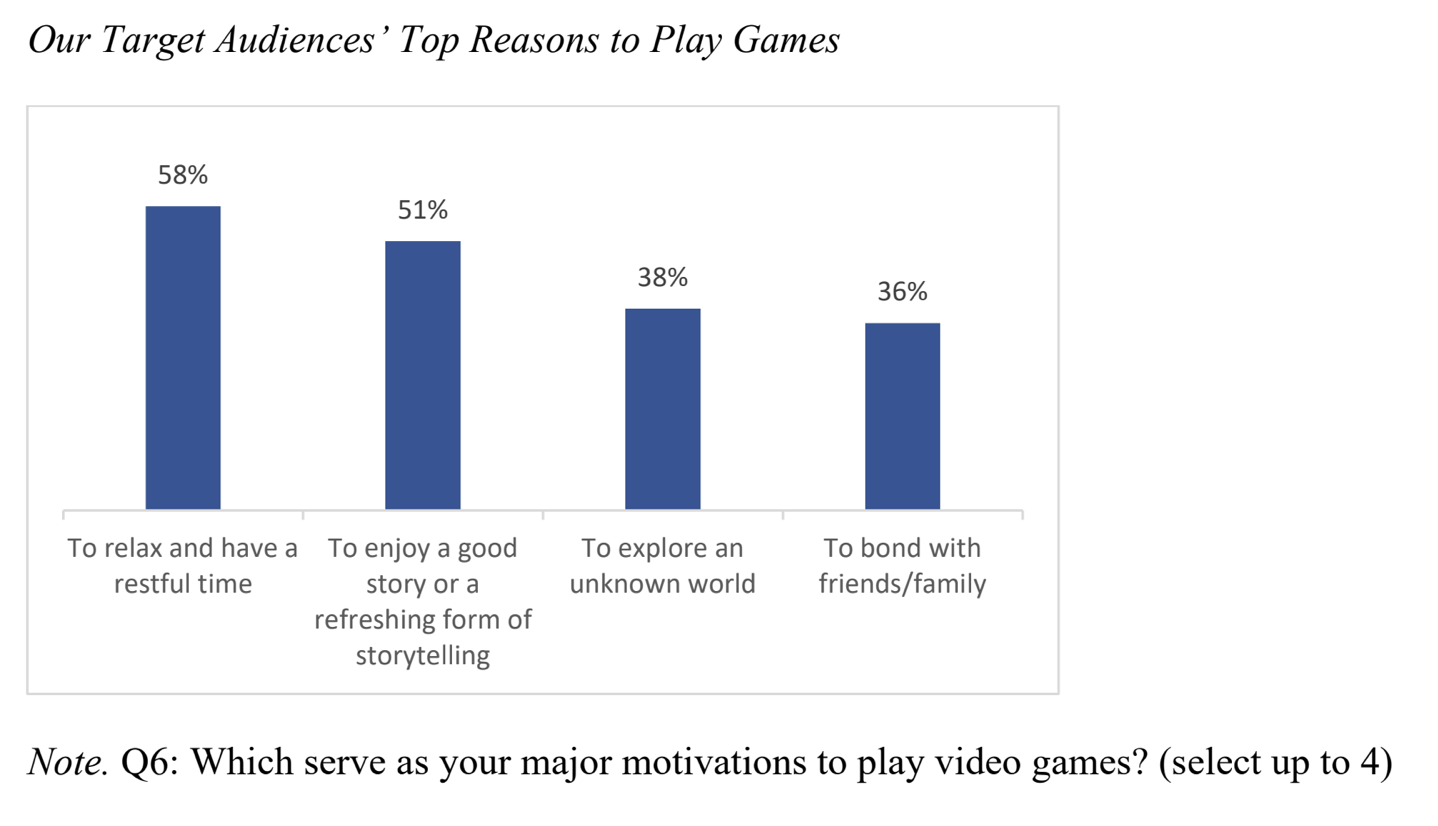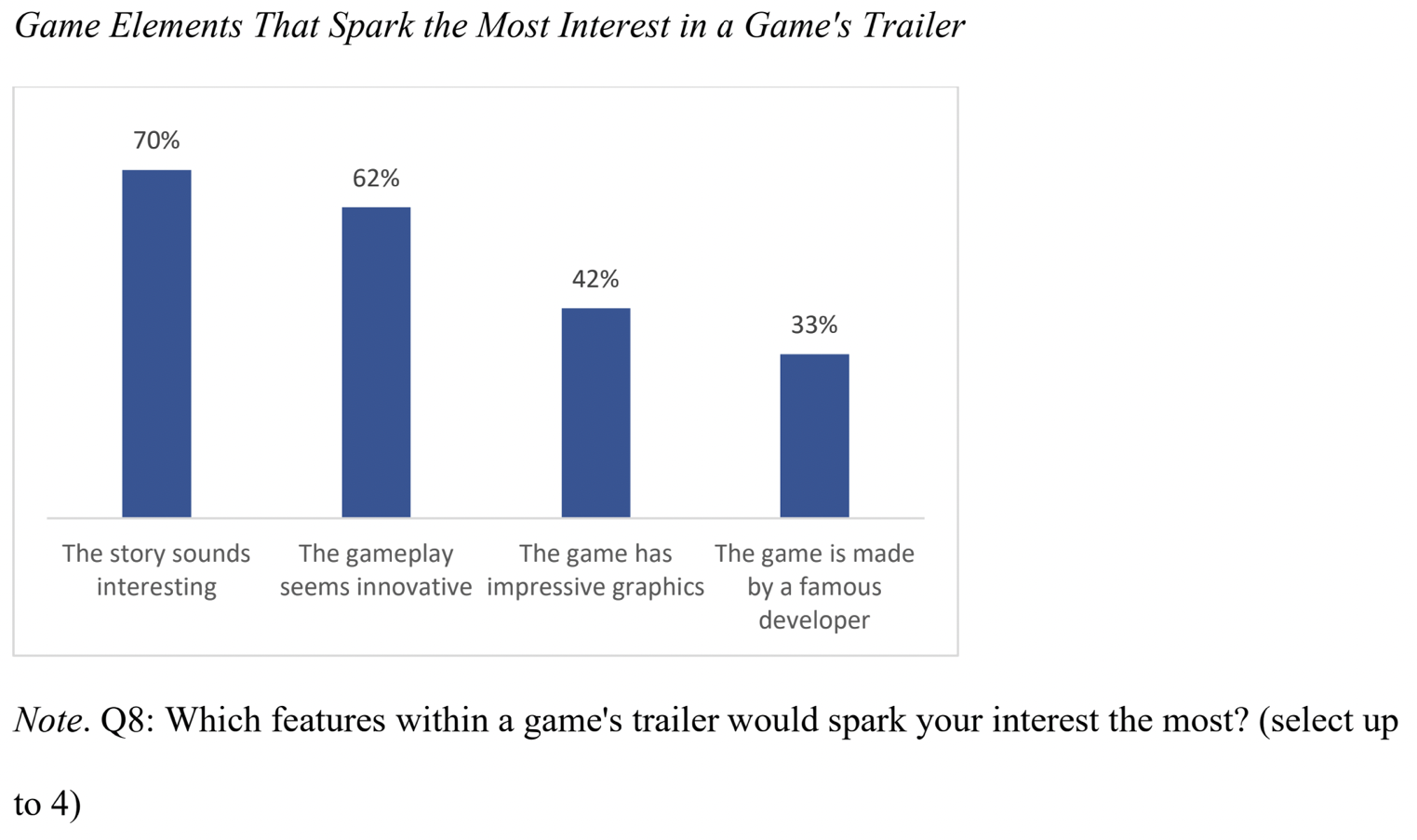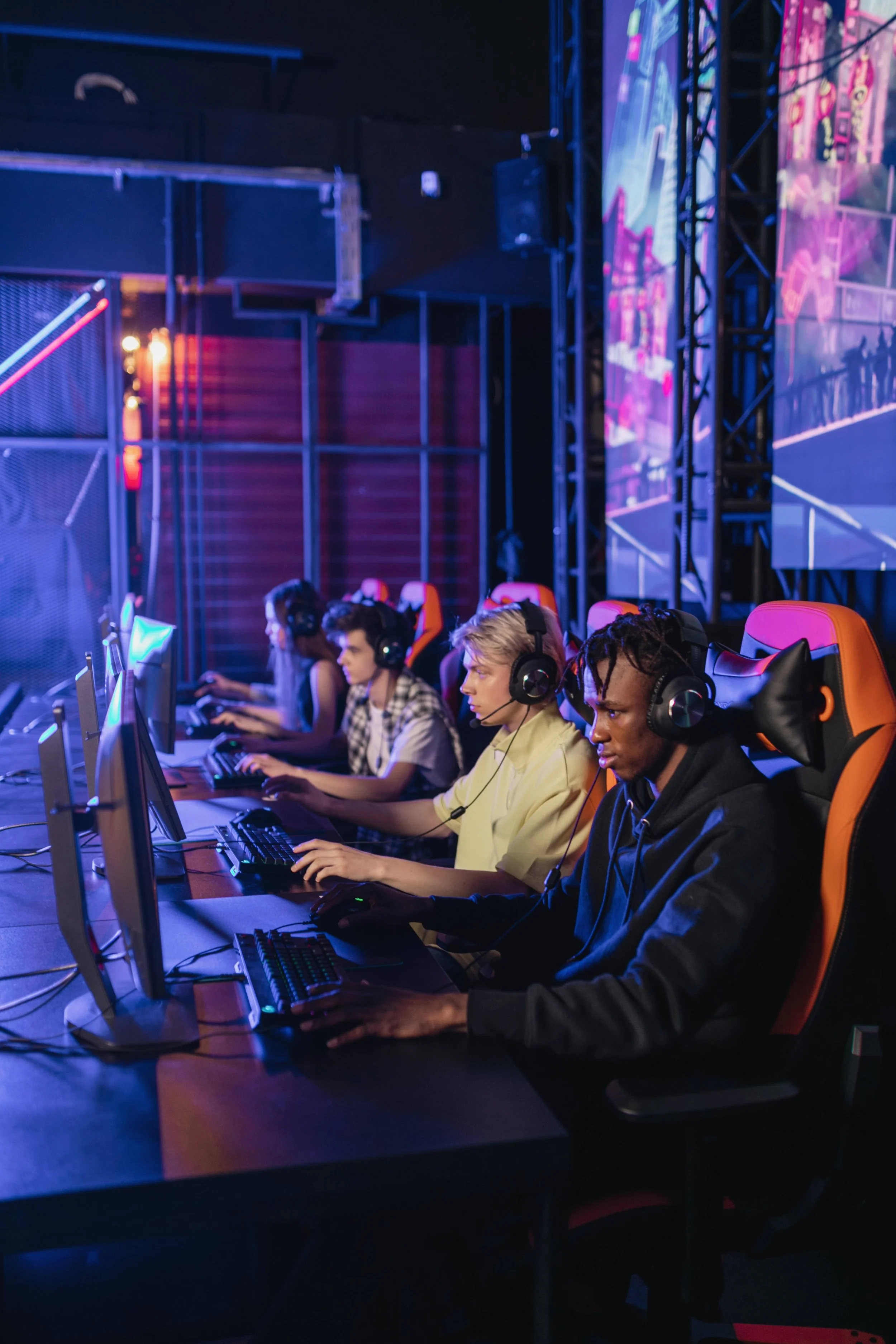By: Matthew Fiacco, Siya Khanse, Anran Liao, Xiaofo Pan, & Daniela Restrepo
The global gaming market is expanding rapidly, and with it comes a diverse range of gaming audiences. However, a significant number of players, especially those from marginalized groups such as women, LGBTQIA+, and racial minorities, are reluctant to engage with gaming communities and lack a sense of belonging. Our research examined the current gaming landscape, allowing our video game marketing client, Cheat Code (a division of Omelet) to develop effective strategies that resonate with the diverse audience of midcore and hardcore games. We found that Diversity, Equity, and Inclusion (DEI) initiatives incorporated by a gaming company can increase players' willingness to participate in the communities. Authentic and accurate representation is crucial for effective messaging. Players are more excited to see marketing campaigns that reflect their lifestyles, playstyles, and gaming habits than those that reflect their genders, races, and other social identities. Authenticity in marketing comes from a diverse workforce. To establish genuine communication and build a sense of belonging, it is essential to have a marketing team that reflects the diversity of the gaming community. Our research underscores the importance of leveraging inclusive, authentic marketing strategies to create a space where all players of midcore and hardcore games can find a sense of belonging, thus increasing consumer engagement and business success.
Image: Gaming Console
Image Source: Unsplash
The gaming industry has emerged as the largest entertainment sector globally, with a staggering revenue of nearly $185 billion in 2022 from 3.2 billion players worldwide (Wijman, 2023). Our client, Cheat Code, is a division of Omelet, an established advertising agency, with a specialty in creating integrated marketing campaigns and branded experiences for gaming clients. Cheat Code seeks a comprehensive understanding of the gaming audience. As the gaming division of a premiere marketing organization, one of Cheat Code’s primary goals is to create marketing plans that will engage all types of players. Cheat Code’s clients include several major gaming organizations, such as The Pokémon Company, Blizzard, and Ubisoft. Cheat Code utilizes expertise in gaming markets and audiences to craft effective marketing materials and actionable plans (Cheat Code, n.d.).
Our research confirmed that gaming audiences are more diverse than ever. Among U.S. consumers of video games, 46% are women, 40% are either Latinx, Black, or Asian American, and 16% are LGBTQIA+ (Ngoc, 2022). The space of midcore and hardcore games is also not dominated by men anymore: women and non-binary people constitute more than 40% of RPG players (Newzoo, 2022a) and one-third of shooter players (Newzoo, 2022b). However, while those who consume are vastly diverse, those who produce are still predominantly white men. Over 61% of game developers worldwide are men and 67% are Caucasian (Weststar et al., 2021).
Overview
In 2022, a staggering 3 billion people engaged in video games. This number is only expected to grow with every passing year (Clement, 2022). The gaming industry is seeing unprecedented success, which has been accelerated by the COVID-19 pandemic (VentureBeat, 2022). The audience is bigger and more diverse than ever. As gaming continues to grow, it is crucial for companies to understand their audience, including how to best attract and engage them.
Researchers have found that 48% of gamers identify as female, and 29% identify as a person of color in the US alone (Play Today, 2022). Further, a survey conducted by Meta found that underrepresented gamers were more likely to feel excluded from games and less likely to engage with communities (Meta, 2022, as cited in Toh, 2022, p. 6). In particular, 56% of Asian American and Pacific Islander (AAPI) gamers would rather stay anonymous in gaming communities, as found in a study by Newzoo (Ngoc, 2021). These facts raise questions about who is publicly identifying themselves as gamers, and whether everyone in the gaming community is being appropriately engaged by gaming marketers. Cheat Code wants to improve the gaming experience for all by improving the engagement between gaming companies and their real audiences. In order for deeper engagement to be achieved, those companies need to obtain a better understanding of who is playing video games today and how to effectively communicate with them.
Image: Omelet - Cheat Code
Image Source: https://www.cheatcode.omelet.com
The existing literature and research on video games and representation shed some light on the players of video games and the workforce in the gaming industry, but far less on diversity and representation in game marketing and advertising. These studies, though sparse, demonstrate some existing problems in the industry. One study conducted by Bowling Green State University analyzed 70 game commercials from 2003 to 2017 in order to understand racial, gender, and age representations in video game advertisements. This study found that video game advertisements often underrepresented several demographics including women, racial minorities, and non adults. Even though some video game advertisements featured women, no advertisement showed women actually playing games (Vollbach, 2018). Another study conducted by the University of Missouri in 2014 examined 383 US magazine advertisements of video games and found the upholding of stereotypical representations of women and racial minorities (Behm-Morawitz, 2014). Moreover, one study conducted by Feminist Frequency discovered that of the games showcased during the 2016 Electronic Entertainment Expo, games featuring male protagonists outnumber those with female protagonists by a staggering 13 to 1 ratio (Petit, 2016). However, these studies are relatively dated. The diversity and representation in video game marketing and advertising has changed dramatically in recent years. Our research intends to fill the gap.
Background Foundation
At the 2022 GI Live Online, an online conference held by the established gaming news website GameIndustry.biz, an executive from Newzoo, the leading games analytics and market research company, stated: “The old stereotype of games being for boys just doesn't exist anymore” (Uppal, 2022, as cited in Wen, 2022, p. 7). The U.S. games market is diverse in terms of gender, ethnicity, sexual identity, and more. Among U.S. gamers, 46% are women. Also, there are 20% identifying as Latinx, 15% as Black, and 5% as Asian American (Ngoc, 2022). Moreover, 16% consider themselves to be a member of the LGBTQIA+ community, and 31% claim they have a disability, with mental health being the most reported (Wen, 2022). It is also noteworthy that minority gamers are steadily growing. Compared to previous data (Newzoo, 2020), gamers who are Black, Latinx, or Asian American have increased by 7% in the last two years, while LGBTQIA+ players have increased by 3%.
When it comes to midcore and hardcore games, the player base may not be as diverse as the entire gaming audience. A study based on a sample of more than three thousand U.S. respondents suggests a gender gap in genre preferences. There are significantly more men than women willing to play game genres such as Shooters, Action, RPG, Sports, Fighting, Racing, and Strategy, while female respondents display a much stronger interest in casual games (Sinclair, 2020). However, it should be noted that men do not completely dominate the playerbase of hardcore games. Other research conducted by Newzoo indicates that women and nonbinary people already account for more than 40% of RPG players (Newzoo, 2022a), and one third of shooter players (Newzoo, 2022b).
Accordingly, many developers of midcore and hardcore games are making efforts to improve representation and inclusion in games and gaming communities. Leading companies have introduced a range of DEI initiatives to set examples for the industry. For instance, Apex Legends, a Battle Royale game launched by Electronic Arts in 2019 that quickly became a massive global hit, has been introducing multiple LGBTQIA+ playable characters and taking great care in creating vibrant personalities, unique abilities, and intriguing lore for them (Lewis, 2022). Out of the five most-selected playable characters in Apex Legends, two are women, one of which is openly gay, and there is also a gender-neutral character (Uppal, 2022, as cited in Wen, 2022). While Electronic Arts is trying to improve in-game representation, Riot Games and Ubisoft, two giants in the game industry with some of the most popular hardcore titles such as League of Legends and Rainbow Six Siege, are working to create a more inclusive community. In 2022, the companies teamed up to launch a research project named “Zero Harm in Comms'' to tackle community toxicity, by sharing databases to “better train AI-based preemptive moderation tools that detect and mitigate disruptive behavior in-game” (Riot Games, 2022, p.2). Additionally, substantial progress has been made in the marketing of midcore and hardcore games. All top ten best-selling games in the United States last year fell into the midcore and hardcore category (Ivan, 2022). Eight of the games released live-action commercials, and they all feature celebrities or actors who belong to one or more social minority groups. The three top selling action games, Call of Duty: Modern Warfare 2, Elden Ring, and God of War: Ragnarök, all collaborate with celebrities such as Nicki Minaj, Lil Baby, LeBron James, Ming-Na Wen, etc. Also, it is noteworthy that two sports games on the list, Madden NFL 23 and FIFA 23, give exposure to female athletes in their commercials. In addition to the aforementioned games that sell millions of copies, popular free-to-play titles in the midcore and hardcore category including VALORANT, League of Legends, and Apex Legends all launched marketing campaigns that pay homage to minority players and give them opportunities to compete within the esports space (Church, 2022; D'Anastasio, 2022; Eure, 2022). Overall, representation and diversity are becoming significant in the marketing campaigns of leading midcore and hardcore games.
Overview of the Gaming Workforce
When considering the overall impact of authentic marketing in gaming, an analysis of the gaming community and workforce is essential in understanding the misconception of who a “gamer” is. A Developer Satisfaction Survey conducted by the International Game Developers Association in 2019 found that 61% of game developers worldwide are men, 30% are women, and 8% are non-binary. As for race and ethnicity, only 4% of developers are Black, whereas 67% identify as White (Weststar et al., 2021). In 2020, a survey found that among the top 15 game companies worldwide, only 16% of the executive teams are made up of women (Wittenberg Cox, 2020). These statistics reflect the commonly held belief that gamers are predominantly White and male, which is not true of the gaming population as has previously been explored. In an effort to challenge and promote change, gaming companies are partnering with other organizations to promote diversity and representation within their own organizations. Women in Games, Epic Games, and the skincare brand Dove launched a campaign, Real Virtual Beauty, encouraging and training female game developers to create diverse game characters, with the intention of "raising the standard for the authentic, diverse, and inclusive representation of women and girls'' (Dealessandri, 2022, p. 4). Do I Look Like a Gamer? is another campaign that challenges the term ‘gamer’ by presenting a diverse group of 40 players and game makers to inspire underrepresented groups to find careers in the gaming industry (Allen, 2022). Addressing the gaps within the workforce and promoting the importance of inclusive hiring practices at the corporate level allows gamers to see themselves not only through gaming content, but also as represented members of the gaming industry as a whole.
Image: About Cheat Code
Image Source: https://www.cheatcode.omelet.com
Research Frameworks
As gaming is a highly interactive medium, it is important for companies to responsibly and effectively engage with their audiences. Therefore, our research attempts to answer the following research question:
1. How can game marketing agencies improve marketing tactics for gaming companies to better engage the actual audience of midcore and hardcore games?
To understand the marketing opportunity, this research also answers:
2. What is an accurate make-up of the gaming industry audience?
3. What are the motivations of video game players?
4. What are some effective communication strategies that may represent and intrigue audiences?
5. Is there a correlation between diversity in the video game workforce and authentic representation in marketing?
Data Gathering and Methodology
The team recognizes this is a large and important topic to marketers and the gaming industry as a whole. To get the best possible understanding of this topic, the team conducted primary research including an anonymous consumer survey and eight interviews with gaming industry professionals. We conducted a survey of convenience with the hope of gaining an understanding of the audience of “core games,” games from genres that are more intense or require more of a commitment for a fuller experience. The survey helped us learn players’ gaming habits, their opinions on the term “gamer,” if they feel included in gaming communities, and what they think of diversity and inclusion topics within gaming. Our interviews were conducted to obtain an understanding of how executives from several fields within gaming think about diversity and inclusion, and the audience shifts they see in their own work.
The team also conducted secondary research from a variety of sources, including published articles, research reports, websites, industry news, social media, podcasts, interviews, industry panels, conferences, and other sources in the gaming industry. Newzoo specifically has done significant research on the audience and workforce of the gaming industry. These data sources were used to understand the existing industry landscape and workforce in gaming companies, as well as to analyze gaming companies’ marketing strategies.
Image: Cheat Code - How We Can Help
Image Source: https://www.cheatcode.omelet.com
Limitations of the Study
We acknowledge that there are limitations to the research we can provide. When sending out our survey, we were limited to our network and the outlets readily accessible to us. We were also unable to review proprietary data from gaming organizations. These constraints limit the amount of data we had access to and made our analysis of the available resources even more crucial. Further, we used a survey of convenience.
Survey Methodology
Our team distributed a survey to understand the perspectives of video game players and determine how those who play midcore and hardcore games prefer to be engaged and represented. We set out to understand whether core players feel included in gaming communities, what types of game marketing they find effective, and if they think game companies should be responsible for making safe communities.
To distribute our survey, we utilized a sample of convenience. We reached out to our own social media networks, posted the survey to several Reddit pages, and took advantage of the website Survey Circle, where users exchange surveys. Overall, we had a sample size of 256, of which 186 respondents completed the survey. We were primarily interested in collecting data on the players of hardcore and midcore games, from here on referred to as our “target audience,” but we collected answers from respondents who exclusively play casual games as well. In total, 184 respondents played either midcore or hardcore games on some platforms, and 72 were players of casual games only.
Survey Participant Summary
Based on our survey findings, our target audience consists of a diverse demographic, with most respondents falling in the age range of 25-34 years (57%). The next largest age group is between 18 and 24 years (27%), followed by 35-44 years (8%) (See Appendix C, Figure 1). In terms of gender, 52% identified as male, 39% as female, 7% as transgender or gender non conforming, while 3% did not want to reveal their identity (See Appendix C, Figure 2). In regard to ethnicity, 55% identified as Caucasian, with 40% belonging to other races (South Asian, East Asian, Black or African American, and Hispanic), and 5% chose not to disclose their ethnicity (See Appendix C, Figure 3). We also found 33% of our respondents identified as members of the LGBTQ+ community (See Appendix C, Figure 4). Lastly, one in four respondents identified as neurodivergent.
Survey Analysis
Initial Findings
Gaming encourages its audience to socialize, whether because a game is multiplayer, has a large online presence, or sparks conversation among social circles. This social desire is reflected in our respondents’ behaviors. As seen in Figure 1, 66% of our respondents informed us one of the main ways they obtain information on video games is through talking with their family and friends. Interestingly, this was a more popular way of receiving information for our target audience than looking up gameplay videos or reading information online.
Image: Figure 1
Image Source: Research Team
As a Google search is convenient for anyone to find information, it is surprising that our target audience is more likely to take the time to speak with others they consider a trusted source for information. Additionally, even online, our target audience seems to prefer when marketers use trusted individuals to convey information. In Figure 2, we find that 39% of respondents in our target audience like to see influencers they follow recommend a game.
Image: Figure 2
Image Source: Research Team
These two data points emphasize the importance of word of mouth. A large portion of our sample is influenced by the opinions of others. If those opinions were strongly negative for any particular reason, it could create issues for video game studios. These points also highlight the importance of the social aspect of video games and their communities, which is validated by the finding that one in three respondents in our target audience play games to bond with friends and family.
Whether it’s to gain information, or simply to enjoy time with friends and family, being social is a high priority for many in our target audience. What’s surprising then, is how few of them enjoy being active in the communities around games.
A Lack of Community Engagement
Though our target audience has expressed an interest in socializing over video games with their own circles, moving to larger communities shows a discrepancy. Among our target audience, 60% informed us they were either only slightly or not at all engaged in the online communities of the games they play, visualized in Figure 3.
Image: Figure 3
Image Source: Research Team
The most frequent reasons for a lack of engagement were that they did not have time to get involved, were not interested in socializing, or that the communities were too hardcore for casual or new players. It is interesting that some of our target audience still feel that they must be hardcore in order to be a part of gaming communities. In fact, 37% of our target audience, despite playing similar games to the other 63%, said they would not consider themselves “gamers.” As can be seen in Figure 4, there is a wide variety of reasons players reject the term “gamer.”
Image: Figure 4
Image Source: Research Team
It is upsetting that people feel excluded because they do not play the types of games they think they need to in order to be considered a gamer, or simply that they do not “look like a gamer.” When looking closer at who does and does not consider themselves a gamer, the problem becomes more concerning, as significantly fewer women consider themselves gamers than men despite playing similar games.
Image: Figure 5
Image Source: Research Team
Alarmingly, when asked what games came to mind when considering DEI issues, several responses from women went into further detail about feeling marginalized or targeted in gaming communities. One respondent informed us: “I've experienced harassment while playing online games such as World of Warcraft. I no longer use voice chat or talk about myself with people online. It's better if they assume I am male.” Another said, “I'm only marginally involved in two communities and they're both for games that have a higher female and queer base than the others. Gamers are toxic.” It is evident that many in our target audience still feel unwelcome online. Commonalities in Content Marketing Preferences. Our data suggests the target audience is social, but they tend to avoid socializing within communities. This feels like a missed opportunity, as a significant portion of our target audience shares similar interests in gaming. As seen in Figure 7, 58% of our respondents play games to have a relaxing time, and 51% play to enjoy a good story or unique form of storytelling.
Image: Figure 6
Image Source: Research Team
This result from our core players is surprising, as traditionally hardcore and midcore games are defined by their gameplay genre, as opposed to their story. Perhaps the increased desire for story is due to the rapid growth in the industry, and the demand for more cinematic experiences from home. More of our target audience informed us they prefer seeing stories in trailers for a game than gameplay, identified in Figure 7.
Image: Figure 7
Image Source: Research Team
A good story is something easy for a massive amount of people to enjoy. Gameplay, what a player actively does within a game, is a crucial component of that game. However, only 17% of respondents in our target audience informed us that they are interested in seeing trailers that feature players from minority groups, indicating consumers may consider this tokenism, and very surface-level diversity. In fact, DEI is important to our core players. 83% of respondents informed us that they either consider DEI to be extremely important, or somewhat important to gaming companies.
The Target Audience Wants Inclusivity
Our survey results suggest that core players, though distinctive, share similar gaming motivations and marketing preferences. A major gaming incentive for core players is bonding with friends or family. Also, most of them acquire information about new games through conversations with friends and acquaintances. However, a significant portion of core players are reluctant to engage in gaming communities and unwilling to call themselves “gamers”. The numbers further increase when it comes to female or LGBTQIA+ respondents. Though social motivation is critical for the players to know and enjoy games, a substantial proportion of them — many who belong to one or more marginalized groups —fail to find a sense of belonging.
An overwhelming majority of core players value diversity and inclusion in video games, yet more than half do not view diversity and inclusion as a top priority. The story, gameplay, and graphics are the chief reasons for players to try a new game. Authenticity and accuracy are crucial when it comes to DEI practices in marketing. Most respondents prioritize accurate representation over positive representation and are more excited to see people in game commercials who share their lifestyles and playstyles than their social identities. Our professional interviewees agreed that authenticity is the key to effective messaging. To create authentic content, a diverse workforce is necessary. The ultimate solution to authentic messaging is to build a creative team as diverse as the player base.
Image: Neon Gaming Sign
Image Source: Unsplash
It is likely DEI is at the front of many of our target audience’s minds. Among our target audience, 39% informed us they have responded negatively, or even taken some action against a game due to a lack of or poor DEI, such as feeling reluctant to be actively involved in a game’s community, feeling reluctant to recommend a game, or reducing their gaming frequency and intensity.
Moreover, 79% of respondents expect companies to take action to make their communities safe and inclusive. From the marketing, the fan community, and even the issues executives choose to stay silent on, a company’s actions matter to its audience. Additionally, 68% of our respondents expect companies to take a clear stance on divisive social issues to express support for marginalized people.
Ultimately, our audience just wants to be seen for who they are. Within our target audience, 66% say they value accuracy over positivity in the representation of women, racial minorities, and other marginalized people in game trailers. Another 69% are more excited to see people in game commercials who share a similar lifestyle, play style, and gaming preferences instead of gender, racial, sexual, and cultural identities. People want to be able to act and be seen as authentically as possible to feel comfortable within gaming.
Industry Interviews
Industry interviews were conducted over the course of three months, beginning on November 29, 2022 and completing on January 6, 2023. Audiences have experienced noticeable shifts in the gaming industry, evolving alongside advancements in technology. Creative Director at Riot Games, believes that different genres see different rates of success across the globe:
Console/PC games are very heavy in Europe and the US: people actually have machines at home. If you look at Asia (China, Japan, Korea): a lot of people have LAN cafes… Then, you look at South America, Central America, Southeast Asia: very mobile heavy, because most people actually can't afford computers. (personal communication, 12/14/2022)
Due to a general lack of accessibility, economic status, and the expensive nature of gaming devices, international markets tend to lean towards mobile or public PC gaming. Riot Games, the creator of the popular League of Legends franchise which has dominated the market for years, also created both Wild Rift and Teamfight Tactics spinoff titles to appeal to the mobile player, with the latter ultimately being the company’s second-highest-grossing game (personal communication, 12/14/2022). The medium available can define the types of games consumers gravitate towards, and who makes up those audiences. Access to different consoles and devices has diversified the content available to the consumer: “different genres of games do better in different parts of the world” (personal communication, 12/14/2022). Advancements in the gaming space, and a cheaper means of production, have also allowed for this growth in the industry overall.
Acknowledging shifts in technology and global demographics was integral in understanding how to best connect with consumers. Both the Creative Director and Senior Product Marketing Manager at ProbablyMonsters agreed on music as an effective means of connecting with consumers: “there's a lot of ties between the type of games you play and the type of music you like. And that can also inform what you use in a campaign” (personal communication, December 13, 2022). To further support this argument, Riot has seen huge success, monetarily, through the creation of their virtual K-pop band, KDA: “I think this is better marketing than [even] Arcane (League of Legends)… In terms of direct dollars to entertainment, KDA was created to sell skins, their outfits, and they created a chart topping [band]” (personal communication, December 14, 2022). The use of music, and other avenues like television and film across the entertainment industry, are useful when connecting to audiences through marketing.
The intersection of gaming, other industries, as well as the available medium can really define the type of content consumers gravitate towards and the way in which games are being developed. The Head of Production at MetaVenture Studios, believes games are generally produced with their audiences at the forefront of development:
Older skewing TV shows like Jeopardy!, Who Wants to Be A Millionaire, Wheel of Fortune - all have games on devices like Alexa, Mobile Phones and PlayStations… As gamer demographic[s] change over time, companies tackle the changes by updating content in line with the change. (personal communication, December 16, 2022)
On another note, Founder of 2063 Productions, believes the space has not really shifted:
When I started in gaming, gamer demographics were boys 8-12. That was a very specific, very refined demographic... Now, who's not a gamer? From every age, to any gender, to every country in the world: every corner that you can think of somebody's a gamer (personal communication, November 29, 2022).
As much as gaming has evolved from the original platformer, 8-bit model era of PacMan and Mario, they argue that audiences are not reflected to the extent of which the gaming demographic has expanded: “part of the reason we haven't realized that full potential is that game developers are still not as diverse as the population.” The gaming audience is more diverse than ever before, and whether or not gaming content has kept up with the landscape is a valid question, especially for companies like Omelet who want to create authentic, relevant marketing for these new players. Authenticity, however, can be achieved through an understanding of who the gaming audience is, and how to effectively reach that target. An executive at Amazon argues that representation in marketing is often perceived as inauthentic because it is not prioritized at the development level:
If you are reflecting diversity in your game design, it's much easier to pull that into your 15-second ad… because the game, at its core, celebrates [everyone] and brings it in a way that is a reflection of modern society (Anonymous, personal communication, February 14, 2023).
Similarly, Director of Equity and Inclusion EMEA at Warner Bros. Discovery, who has worked within the gaming space for Rocksteady Studios, argues that the responsibility lies on the shoulders of the companies involved in creating content, whether on the production side or not:
It is critical to pressure test [your] work first, internally, with the diverse variety of identities within the studio and, secondly, to be able to test it with ... potential consumers of the game around the globe to understand how to connect it most authentically. ( personal communication, December 15, 2022)
In alignment with the point made earlier, there is an inherent need of hiring a diverse workforce within a company, as an initial step, to create authentic content and marketing materials. Both the survey and interviews reinforced the fact that DEI practices and initiatives are valued, but not the most important factor for a game’s success. Survey respondents indicated that story and gameplay are the most important elements when marketing a game. In interviewing gaming professionals across varying business units, accessibility to technology, a genuine approach to creating marketing tactics and campaign partnerships, and the importance of community and fandoms were all resounding factors in measuring how audiences interact with games currently. Authentic messaging is more effective when a gaming title is also authentic, diverse, and inclusive at its core.
Final Analysis
As the gaming audience becomes bigger and more diverse than ever, the needs of the audience will grow with it. Our survey results and interviews reveal key insights about game marketing that highlight the unifying aspects that unite game players and what engages them the most. We will break down the analysis into the following sections: Community, Content Marketing, Authentic Representation, and Workforce Diversity.
Building Strong Communities
Game communities offer a shared space where players can socialize, learn, support each other, and have fun while engaging with their favorite games. Given that nearly three-quarters of our target audience receive information about games through talking to friends and family, we consider word of mouth a major marketing element for many hardcore or midcore games. If the community generates negative word of mouth, new players could be less likely to pick up the game. Therefore, fostering a safe and healthy community that promotes positive word of mouth is crucial. However, most of our respondents reported not spending much time in gaming communities. Many felt the communities were toxic, not vibrant enough (lacks diversity), or too hardcore for newcomers or casual players to engage in. Concerningly, some respondents feared getting harassed, bullied, and rejected by community members.
These communities are important to the life and sales of a game, especially franchise games like Call of Duty or any that fall under the Games-as-a-Service category, like Overwatch 2. The more people online discussing or streaming a game, the more potential sales and players that game could receive. For example, the game Among Us was released in 2018 and fizzled out quickly. However, in 2020, the game skyrocketed from 10 million downloads on the Google Play store to over 100 million downloads within three weeks (Fenlon, 2020). The primary reason for Among Us' significant spike was Twitch streamers, who exposed the game to hundreds of thousands of viewers who, in turn, spread the word among their social circles. Without the presence of a strong community, a game can miss out on profitability it would otherwise have. Many of our interviews echoed this concern:
Community is such an important part of a game, to the point that it can very easily make or break the title. A game with a strong community/fandom, even if the product itself isn't that great, could still have a lot more longevity than… an amazing game [that] nobody wants to play. (personal communication, December 1, 2022)
Image: Diverse Gaming Community
Image Source: Pexels
About one in three survey respondents reported being interested in real-world events hosted by video game companies. These events are a manifestation of the game's fandom or the game itself. For example, The Pokémon Company annually holds the Pokémon World Championships for a massive in-person crowd. In 2022, the event had 5,000 competitors and 4,000 spectators (Wrack, 2022). Fans attended the event to participate in various activities, from tournaments to scavenger hunts. The event has a massive reach online as well. The video for the final day of the competition on Pokémon's official English YouTube Channel currently holds over 656,000 views. Not all gaming franchises can reach the same heights as Pokémon, but they can all hold events appropriate to their own scale.
Physical events like these allow a community and the brand's strength to be on full display while allowing fans and consumers of games to interact with the creators. Gaming conventions also provide players and fans a chance to connect with creators which in turn can foster a sense of recognition. Additionally, the very act of hosting a physical event, especially one of a large scale, can generate buzz and reach untapped audiences, making it a powerful marketing tool to maximize a game's exposure. Ultimately, a safe gaming community can boost trust, generate positive word of mouth among players, and encourage newcomers to join in. Therefore, for gaming companies, building and maintaining communities to create a safe and inclusive environment is key to retaining their existing audience and engaging further with them.
Universal Elements in Content Marketing
A majority of our respondents are excited to watch game trailers that highlight engaging narrative and innovative gameplay. It is also worth noting that highlighting a famous and well reputed company in the trailer piqued the interest of one-third of our target audience. Therefore, it is crucial to prioritize these key elements to unify a diverse playerbase. This was echoed when asked if the gamer demographic affects the way games are produced:
At the heart of the production is the craft. You're still going to have to design a level the same way, you're still going to have to write a story a certain way. If you take God of War, for example, I don't think having a dynamic of... a dad and a son [is most important]. I'm a female, and I [still] love that story. (personal communication, December 13, 2022)
Representation still matters, and players certainly care about it. However, it must go beyond on screen visibility and involve an accurate depiction of the diverse experiences players have.
Representation Beyond Surface-Level Diversity
A vast majority of our respondents value DEI practices. The absence of DEI practices can compel players to take actions that would adversely impact the game, whether abandoning it or refraining from recommending it to anyone. With word of mouth being one of the most important factors for a game to grow organically, game companies should avoid such hindrances in organic marketing. Therefore, game companies will want to ensure their games reflect strong and accurate DEI practices that players feel proud of while talking to their friends and family. There is an increasing need for gaming companies to acknowledge and act on social issues that our playerbase cares about. Players today expect real actions from companies that go beyond tokenized representation. This includes making proactive efforts to make communities safe and inclusive and uplifting marginalized people by taking a stance on issues that affect them. These actions are crucial to causing a deeper change that creates a more equitable community. While accurate representation and good DEI practices may not directly grow a game's audience size, misrepresentation, toxic communities, or ignorance of social issues can certainly shrink a game's audience.
When it comes to representation, players appreciate authenticity and sincerity. In May 2022, Activision Blizzard created the Diversity Space Tool, assigning numerical values to superficial character traits such as age, culture, body type, gender, and sexual identities. Even though the creators had the good intention to diversify their characters, it was met with a storm of outrage for its tokenistic and oversimplified approach (Tassi, 2022). Companies need to do better than simply quantifying diversity: DEI requires more nuanced and thought-through practices. For instance, if a game features an underrepresented character, their culture, lifestyle, traditions, language, or history should be thoughtfully incorporated into the character's development. Only when diversity is authentic from the core can it be reflected in marketing or else, rightfully so, it can be perceived as tokenism.
Workforce Diversity is Crucial to Authenticity
As a participant informed us, it is easy to tell when diversity within a company is inauthentic. For DEI efforts to be genuine and authentic, gaming companies need to embrace DEI not only in their products but also in their hiring practices. Companies that attempt to market themselves as diverse or inclusive without prioritizing diversity in their workforce and practices run the risk of being called out for performative efforts. Instead, we believe all companies in the gaming industry, marketing-centric or otherwise, should take the time to build a diverse workforce and listen to voices from different backgrounds.
A truly diverse workforce, with creators and marketers from varied backgrounds, brings unique perspectives to the table. When the employees live and breathe the realities players experience, they are better equipped to create games and gaming content that deeply resonate with their audiences. An inclusive workforce minimizes instances of tokenization and nurtures an inclusive culture that naturally reflects in the games.
Recommendations
To embrace and engage with the diverse audience of core players, Cheat Code should consider the following recommendations. These strategies will help game companies create a more diverse and inclusive gaming community, authentically engage with underrepresented game players, and increase the sales for game companies.
Create Casual Events for Core Players
Game companies should create events that are welcoming and accessible for core players. Casual events break down barriers for participants to build interpersonal connections within gaming communities. These events could be online or in-person. Online events could include fanart sharing and cosplay contests to showcase players’ passion and creativity. In-person events could include pop-up shops, fan conventions, and meet-and-greets, to further increase the reach by attracting those audience members who are not active in online communities or prefer in person engagement. By encouraging the participation of core players regardless of their gaming skills and facilitating interpersonal connections, these events can generate positive word-of-mouth within and beyond gaming communities.
Empower underrepresented influencers to share their unique experiences.
Encouraging diverse creators to produce authentic content is crucial in capturing the hearts of underrepresented groups. Unique, personal stories from creators in marginalized groups will convey the most authentic messages and resonate with underrepresented players who share similar lifestyles and playstyles. This will draw in more diverse players and foster a more inclusive community, reinforcing the game's inclusivity and can promote growth in the long run.
Utilize Characters and Narratives to Prove Authenticity
Marketers should leverage characters and narratives to provide heartfelt or engaging worlds that players can get lost in. The depth and complexity of the characters and stories within a game lead to authenticity. By utilizing these elements to unite core players in shared experiences, game companies can foster a more cohesive community with authentic messaging related to core players, resulting in increased sales for game companies.
Prioritizing Authenticity in Target Audience Representation
Rather than resorting to tokenism in marketing with the perfunctory inclusion of one or two players from marginalized groups, game companies should research their target audiences’ gaming behaviors, such as lifestyles, playstyles, and gaming preferences. Game companies can then incorporate a relatable, authentic, and accurate representation of the target audience, which is more effective in resonating with underrepresented groups of game players, leading to positive word-of-mouth marketing.
Amplify Underrepresented Voices Within the Gaming Workforce
A game may only be as diverse as its creators, and amplifying the voices of those individuals at the corporate level is the first step to achieving that. Companies should not only diversify their own workforce but also utilize various platforms to create marketing campaigns that highlight their efforts and initiatives toward promoting workforce diversity. This is an essential stepping stone to DEI practices and authentic messaging in game marketing.
Conclusion
Cheat Code should help cultivate inclusive and diverse gaming communities through online and in-person community events and diverse influencers’ content, highlight character and narrative in their content marketing, and ensure authentic and accurate representation of their audience. Most importantly, Cheat Code should amplify underrepresented voices within the workforce. Incorporating DEI practices in game marketing is not just about boosting sales or building a better brand, but also about creating a brighter future in the gaming industry.
Future research on DEI in game marketing could focus on measuring the effectiveness of different practices in game marketing campaigns. We believe that examining these campaigns’ effectiveness, such as awareness and conversations online, could help game companies make data-driven decisions on when and how to incorporate DEI practices in marketing. Additional research could also investigate the perceptions of DEI practices for game marketing in international territories, as our research mainly focuses on the game players in the United States. Moreover, given that we found toxicity is still prevalent in gaming communities, it is essential to examine the toxic traits of these communities. As the global gaming audience becomes more diverse, this research could prepare gaming and marketing companies to not only authentically connect with their current audiences, but also create an inclusive, engaging environment that keeps drawing new players.
-
About Us – Women in Games. (2023, February 2). Retrieved February 5, 2023, from https://www.womeningames.org/about-us/
Allen, J. (2022, March 14). How do I look like a gamer aims to promote diversity and inclusivity in the games industry. NME. Retrieved January 30, 2023, from https://www.nme.com/features/gaming-features/how-do-i-look-like-a-gamer-aims-to promote-diversity-and-inclusivity-in-the-games-industry-3180664
Behm-Morawitz, E. (2014). Examining the intersection of race and gender in video game advertising. Journal of Marketing Communications, 23(3), 220–239.
https://doi.org/10.1080/13527266.2014.914562
Bennett-Cohen, J. (2022, February 28). What are Battle Royale Games? MUO. Retrieved March 7, 2023, from
https://www.makeuseof.com/what-are-battle-royale-games/
Cheat Code. (n.d.) Cheat Code. Omelet. Retrieved November 4, 2020 from: https://www.cheatcode.omelet.com/
Church, B. (2022, February 1). The game boosting diversity in esports and creating role models for the next generation. CNN. Retrieved February 4, 2023, from
https://www.cnn.com/2022/02/01/sport/valorant-esports-women-diversity-spt intl/index.html
Clement, J. (2022, November 11). Global video game users 2027. Statista. Retrieved March 6, 2023, from https://www.statista.com/statistics/748044/number-video-gamers-world/ Dealessandri, M. (2022, September 23). Epic, women in games and Dove launch campaign to improve female character diversity. GamesIndustry.biz. Retrieved January 30, 2023, from https://www.gamesindustry.biz/epic-women-in-games-and-dove-launch-campaign to-improve-female-character-diversity
D'Anastasio, C. (2022, September 2). League of Legends Women's League planned by Riot Games. Bloomberg. Retrieved February 4, 2023, from
https://www.bloomberg.com/news/newsletters/2022-09-02/league-of-legends-women-s esports-league-circuit-is-in-the-works
Eure, J. (2022, August 18). Women take the stage at the Apex Legends Global Series Championship. Lenovo Story Hub. Retrieved February 4, 2023, from
https://news.lenovo.com/women-take-stage-apex-legends-global-series-algs championship/
Fenlon, W. (2020, September 24). How among US became so wildly popular. pcgamer. Retrieved March 6, 2023, from https://www.pcgamer.com/how-among-us-became-so popular/
Goslin, A. (2021, November 16). Riot Games surprise-releases Ruined King RPG and announces more games. Polygon. Retrieved May 7, 2023 from
https://www.polygon.com/22784089/ruined-king-league-of-legends-riot-games-hextech announcement
Havermale, A. (2022, September 4). 'Arcane' Wins Emmy for Best Animated Program. Collider. Retrieved May 7, 2023 from https://collider.com/arcane-emmy-best-animated-program netflix/
Holt, K. (2023, May 2). 'Convergence: A League of Legends Story' will arrive on May 23rd. Engadget. Retrieved May 7, 2023 from https://www.engadget.com/convergence-a league-of-legends-story-will-arrive-on-may-23rd-165600767.html
Ivan, T. (2023, January 16). NPD has revealed the best-selling games of 2022 in the United States. Video Games Chronicle. Retrieved February 4, 2023, from
https://www.videogameschronicle.com/news/npd-has-revealed-the-best-selling-games of-2022-in-the-united-states/
Lewis, C. (2022, October 17). Catalyst Is Apex Legends' First Transgender Character. Gamespot. Retrieved May 9, 2023, from https://www.gamespot.com/articles/catalyst-is apex-legends-first-transgender-character/1100-6508343/
McKinsey & Company. (2022, August 17). What is diversity, equity, and inclusion?. McKinsey & Company. Retrieved April 8, 2023, from https://www.mckinsey.com/featured insights/mckinsey-explainers/what-is-diversity-equity-and-inclusion
Murko, D. (2023, January 6). Most Watched Esports Games of 2022. Esports Charts. Retrieved March 7, 2023, from https://escharts.com/news/m4-world-championship-group-stage recap
Murray, R. (2021, May 3). Role playing games. Game Design Development 2021. Retrieved March 7, 2023, from
https://ecampusontario.pressbooks.pub/gamedesigndevelopmenttextbook/chapter/role playing-games/
Newzoo. (2020, November 12). U.S. key takeaways: Diversity & Inclusion Study. Newzoo. Retrieved February 4, 2023, from https://newzoo.com/insights/infographics/u-s-key takeaways-diversity-inclusion-study
Newzoo. (2022a, December 5). Role-playing games (rpgs) revealed: Newzoo Game Genre Report. Newzoo. Retrieved January 15, 2023, from https://newzoo.com/insights/trend reports/role-playing-games-rpg-revealed-newzoo-game-genre-report
Newzoo. (2022b, December 5). Shooter games revealed: Newzoo Game Genre Report. Newzoo. Retrieved January 15, 2023, from https://newzoo.com/insights/trend-reports/shooter games-revealed-newzoo-game-genre-report
Ngoc, M. (2021, September 30). D&I in gaming: Insights into Asian American and AAPI GamersMinh. Newzoo. Retrieved February 1, 2023, from
https://newzoo.com/insights/articles/diversity-inclusion-study-shining-the-spotlight-on asian-american-and-pacific-islander-aapi-gamers
Ngoc, M. (2022, April 8). Diversity, Equity & Inclusion in Games: Gamers Want Less Toxicity in Games and Want Publishers to Take a Stance. Newzoo. Retrieved February 1, 2023, from https://newzoo.com/insights/articles/newzoos-gamer-sentiment-diversity-inclusion gender-ethnicity-sexual-identity-disability
Omelet. (n.d.) Omelet. Retrieved November 4, from https://www.omelet.com/
Pavlovic, D. (2020, July 23). Video game genres everything you need to know: HP® Tech takes. Video Game Genres Everything You Need To Know | HP® Tech Takes. Retrieved March 7, 2023, from https://www.hp.com/us-en/shop/tech-takes/video-game-genres
Patel, N. (2021, September 3). What is games as a service (GaAs) and what does it mean for marketers? Neil Patel. Retrieved April 8, 2023, from https://neilpatel.com/blog/gaas/
Petit, C. (2016, December 31). Gender breakdown of games showcased at E3 2016. Feminist Frequency. Retrieved January 30, 2023, from https://feministfrequency.com/2016/06/17/gender-breakdown-of-games-showcased-at e3-2016/
Play Today. (2022, September 20). Gamer demographics from 2022: No longer a men's only club. PlayToday.co. Retrieved December 3, 2022, from
https://playtoday.co/blog/stats/gamer-demographics/
Read, S. (2022, July 22). Gaming is booming and is expected to keep growing. This chart tells you all you need to know. World Economic Forum. Retrieved December 1, 2022, from https://www.weforum.org/agenda/2022/07/gaming-pandemic-lockdowns-pwc-growth/
Riot Games. (2022, November 16). Riot games and Ubisoft tackling toxicity in games with new project. Riot Games. Retrieved February 4, 2023, from
https://www.riotgames.com/en/news/riotgames-ubisoft-tackling-toxicity-in-games-with new-project
Sattar, M. (2022, October 31). 6 mobas that are perfect for newcomers to the genre. Game Rant. Retrieved March 7, 2023, from https://gamerant.com/best-beginner-multiplayer-online battle-arena-games/
Sinclair, B. (2020, June 3). Study highlights gender gaps in gaming preferences. GamesIndustry.biz. Retrieved February 4, 2023, from
https://www.gamesindustry.biz/studyhighlights-gender-gaps-in-gaming-preferences Stanton, R. (2021, November 17). Arcane's success sees pick rates for the show's characters in League of Legends rocket. PCGamer. Retrieved May 7, 2023, from
https://www.pcgamer.com/arcanes-success-sees-pick-rates-for-the-shows-characters-in league-of-legends-rocket/
Tassi, P. (2021, November 16). ‘Arcane’ Is Netflix’s #1 Show In 52 Countries, But Struggling in the US. Forbes. Retrieved May 7, 2023, from
https://www.forbes.com/sites/paultassi/2021/11/16/arcane-is-netflixs-1-show-in-52- countries-but-struggling-in-the-us/?sh=3e4085ca38a6
Tassi, P. (2022, May 16). Activision Blizzard heavily edits King’s Diversity Generator Blog, removes all “ranking” images. Forbes. Retrieved March 6, 2023, from
https://www.forbes.com/sites/paultassi/2022/05/14/activision-blizzard-heavily-edits kings-diversity-generator-blog-removes-all-ranking-images/?sh=744652553de0 The Official Pokémon YouTube Channel. (2022, August 21). 2022 Pokémon World Championships | CHAMPIONSHIP SUNDAY. YouTube.
https://www.youtube.com/watch?v=kvMjvtzIQao&ab_channel=TheOfficialPok%C3%A 9monYouTubechannel
Toh, E. M. (2022, March 8). Diversity in the gaming industry is an ‘economic imperative,’ says Meta executive. CNBC. Retrieved December 3, 2022, from
https://www.cnbc.com/2022/03/08/diversity-in-the-gaming-industry-an-economic imperative-meta-exec.html
VentureBeat. (January 18, 2022). Total and segment revenue of the video game industry in the United States from 2016 to 2021 (in billion U.S. dollars) [Graph]. In Statista. Retrieved November 04, 2022, from https://www-statista
com.cmu.idm.oclc.org/statistics/249996/annual-revenue-of-the-us-video-game-industry by-segment/
Vollbach, A.M. (2018). Diversity and Inclusivity in Video Game Advertisements: An Exploration of Video Game Console Commercials from 2003 to 2017. Retrieved, from
https://etd.ohiolink.edu/apexprod/rws_etd/send_file/send?accession=bgsu152296836167 2216&disposition=inline&fbclid=IwAR2JVTqzygBbapXbyedSYN100kxaPidnaLrTQuK IJX3lTDsf6fDcPrtrbVM
Wen, A. (2022, June 22). "The old stereotype of games being for boys just doesn't exist anymore" | GI Live Online. GamesIndustry.biz. Retrieved February 4, 2023, from https://www.gamesindustry.biz/newzoo-dei-talk-gi-live-online
Weststar, J., Kumar, S., Coppins, T., Kwan, E., & Inceefe, E. (2021, August 21). Igda developer satisfaction survey 2021 summary report. igda.org. Retrieved February 5, 2023, from https://ir.lib.uwo.ca/cgi/viewcontent.cgi?article=1108&context=usri
Wijman, T. (2023, February 15). The games market will grow by 2.1% to reach $196.8 bn in 2022. Newzoo. Retrieved March 7, 2023, from https://newzoo.com/insights/articles/the games-market-will-show-strong-resilence-in-2022
Wittenberg-Cox, A. (2020, August 28). Gaming industry: Please wait...gender balance loading. Forbes. Retrieved February 27, 2023, from
https://www.forbes.com/sites/avivahwittenbergcox/2020/08/28/gaming-industry-please waitgender-balance-loading/?sh=eb952e3d3045
Wrack, S. (2022, August 24). Still catching 'em all: Why the pokémon world championships are bigger than ever. The Guardian. Retrieved March 6, 2023, from https://www.theguardian.com/games/2022/aug/24/still-catching-em-all-why-the pokemon-world-championships-are-bigger-than-ever


